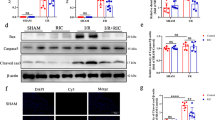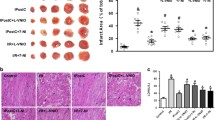Abstract
Angiotensin II (Ang II) has been found to exert preconditioning-like effect on mammalian hearts. Diverse mechanisms are known to exist to explain the cardioprotective abilities of Ang II preconditioning. The present study hypothesized, based on the recent report that Ang II generates reactive oxygen species (ROS) through NADPH oxidase, that Ang II preconditioning occurs through redox cycling. To test this hypothesis, a group of rat hearts was treated with Ang II in the absence or presence of an NADPH oxidase inhibitor, apocynin; or a cell-permeable ROS scavenger, N-acetyl cysteine (NAC). Ang II pretreatment improved postischemic ventricular recovery; reduced myocardial infarction; and decreased the number of cardiomyocyte apoptosis, indicating its ability to precondition the heart against ischemic injury. Both apocynin and NAC almost abolished the preconditioning ability of Ang II. Ang II resulted in increase in ROS activity in the heart, which was reduced by either NAC or apocynin. Ang II also increased both the NADPH oxidase subunits gp91 phox and p22phox mRNA expression, which was abolished with apocynin and NAC. Our results thus demonstrate that the Ang II preconditioning was associated with enhanced ROS activities and increased NADPH oxidase subunits p22phox and gp91phox expression. Both NAC and apocynin reduced ROS activities simultaneously abolishing preconditioning ability of Ang II, suggesting that Ang II preconditioning occurs through redox cycling. That both NAC and apocynin reduced ROS activities and abolished Ang II-mediated increase in p22phox and gp91phox activity further suggest that such redox cycling occurs via both NADPH oxidase-dependent and-independent pathways.
Similar content being viewed by others
References
Xiao, X. H. and Allen, D. G. (2003) The role of endogenous angiotensin II in ischemia, reperfusion and preconditioning of the isolated rat heart. Pflugers Arch. 445, 645–650.
Booz, G. W., Day, J. N., and Baker, K. M. (2002) Interplay between the cardiac renin angiotensin system and JAKSTAT signaling: role in cardiac hypertrophy, ischemia/reperfusion dysfunction, and heart failure. J. Mol. Cell. Cardiol. 34, 1443–1453.
Ferreira, A. J., Santos, R. A., and Almeida, A. P. (2001) Angiotensin-(1–7): cardioprotective effect in myocardial ischemia/reperfusion. Hypertension 38, 665–668.
Sharma, A. and Singh, M. (2000) Possible mechanism of cardioprotective effect of angiotensin preconditioning in isolated rat heart. Eur. J. Pharmacol. 406, 85–92.
Sharma, A. and Singh, M. (2000) Effect of ethylisopropyl amiloride, a Na+−H+ exchange inhibitor, on cardioprotective effect of ischemic and angiotensin preconditioning. Mol. Cell. Biochem. 214, 31–38.
Nakano, A., Miura, T., Ura, N., Suzuki, K., and Shimamoto, K. (1997) Role of angiotensin II type I receptor in preconditioning against infarction. Coron. Artery Dis. 8, 343–350.
Diaz, R. J. and Wilson, G. J. (1997) Selective blockade of AT1 angiotensin II receptors abolishes ischemic preconditioning in isolated rabbit hearts. J. Mol. Cell. Cardiol. 29, 129–139.
Morris, S. D. and Yellon, D. M. (1997) Angiotensin-converting enzyme inhibitors potentiate preconditioning through bradykinin B2 receptor activation in human heart. J. Am. Coll. Cardiol. 29, 1599–1606.
Miki, T., Miura, T., Ura, N., et al. (1996) Captopril potentiates the myocardial infarct size-limiting effect of ischemic preconditioning through bradykinin B2 receptor activation. J. Am. Coll. Cardiol. 28, 1616–1622.
Franco, M. C., Akamine, E. H., Di Marco, G. S., et al. (2003) NADPH oxidase and enhanced superoxide generation in intrauterine undernourished rats: involvement of the renin-angiotensin system. Cardiovasc. Res. 59, 767–775.
Lopez, B., Salom, M. G., Arregui, B., Velero, F., and Fenoy, F. J. (2003) Role of superoxide in moldulating the renal effects of angiotensin II. Hypertension 42, 1150–1156.
Sato, M., Cordis, G. A., Maulik, N., and Das, D. K. (2000) SAPKs regulation of ischemic preconditioning. Am. J. Physiol. 279, H901-H907.
Engelman, D. T., Watanabe, M., Engelman, R. M., et al. (1995) Hypoxic preconditioning preserves antioxidant reserve in the working rat heart. Cardiovasc. Res. 29, 133–140.
Hattori, R., Maulik, N., Otani, H., et al. (2005) Role of Stat 3 in ischemic preconditioning. J. Mol. Cell. Cardiol., in press.
Maulik, N., Goswami, S., Galang, N., and Das, D. K. (1999) Differential regulation of bcl-2, AP-1 and NFϰB on cardiomyocyte apoptosis during myocardial ischemic stress adaptation. FEBS Lett. 443, 331–336.
Cordis, G. A., Maulik, N., and Das, D. K. (1995) Detection of oxidative stress in heart by estimating the dinitrophenylhydrazine derivative of malonaldehyde. J. Mol. Cell. Cardiol. 27, 1645–1653.
Griendling, K. K., Minieri, C. A., Ollerenshaw, J. D., and Alexander, R. W. (1994) Angiotensin II stimulates NADH and NADPH oxidase activity in cultured vascular smooth muscle cells. Circ. Res. 74, 1141–1148.
Rajagopalan, S., Kurz, S., Munzel, T., et al. (1996) Angiotensin II mediated hypertension in the rat increases vascular superoxide production via membrane NADH/NADPH oxidase activation: contribution to alterations of vasomotor tone. J. Clin. Investig. 97, 1916–1923.
Griendling, K. K., Sorescu, D., and Ushio-Fukai, M. (2000) MAD(P)H oxidase. Role in cardiovascular biology and disease. Circ. Res. 86, 494–501.
Das, D. K., Maulik, N., Sato, M., and Ray, P. (1999) Reactive oxygen species function as second messengers during ischemic preconditioning of heart. Mol. Cell. Biochem. 196, 59–67.
Das, D. K. and Maulik, N. (2003) Preconditioning potentiates redox signaling and converts death signal into survival signal. Arch. Biochem. Biphys. 420, 305–311.
Das, D. K. (2001) Redox regulation of cardiomyocyte survival and death. Antioxid. Redox Signal. 3, 23–37.
Maulik, N., Sato, M., Price, B. D., and Das, D. K. (1998) An essential role of NFϰB in tyrosine kinase signaling of p38 MAP kinase regulation of myocardial adaptation to ischemia. FEBS Lett. 429, 365–369.
Maulik, N., Engelman, R. M., Flack, J. E., Rousou, J. A., Deaton, D., and Das, D. K. (1999) Ischemic preconditioning reduces apoptosis by upregulating anti-death gene bcl-2. Circulation 100, II369-II375.
Tosaki, A., Engelman, D. T., Engelman, R. M., and Das, D. K. (1996) The evolution of diabetic response to ischemia/reperfusion and preconditioning in isolated working rat hearts. Cardiovasc. Res. 31, 526–536.
Liu, Y., Tsuchida, A., Cohen, M. V., and Downey, J. M. (1995) Pretreatment with angiotensin II activates protein kinase C and limits myocardial infarction in isolated rabbit hearts. J. Mol. Cell. Cardiol. 27, 883–892.
Zhu, Y. C., Zhu, Y. Z., Gohlke, P., Stauss, H. M., and Unger, T. (1997) Effects of angiotensin-converting enzyme inhibition and angiotensin II AT1 receptor antagonism on cardiac parameters in left ventricular hypertrophy. Am. J. Cardiol. 80, 110A-117A.
Schwarz, E. R., Montino, H., Fleischlauer, J., Kleus, H. G., vom Dahl, J., and Hanrath, P. (1997) Angiotensin II receptor antagonist EXP 3174 reduces infarct size comparable with enalprilat and augments preconditioning in the pig heart. Cardiovasc. Drug Ther. 11, 687–695.
Das, D. K., Maulik, N., and Engelman, R. M. (2000) Redox regulation of angiotensin II signaling in the heart. J. Cell. Mol. Med. 214, 31–38.
Author information
Authors and Affiliations
Corresponding author
Rights and permissions
About this article
Cite this article
Das, S., Engelman, R.M., Maulik, N. et al. Angiotensin preconditioning of the heart. Cell Biochem Biophys 44, 103–110 (2006). https://doi.org/10.1385/CBB:44:1:103
Issue Date:
DOI: https://doi.org/10.1385/CBB:44:1:103




